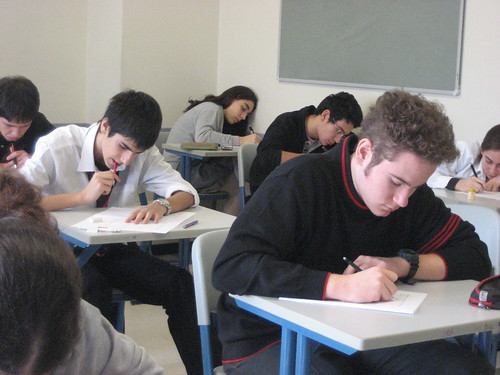
flickr photo shared by marragem under a Creative Commons ( BY-SA ) license
Note: This post is an extended reflection from the EdTech Team’s Teacher Leader Certification Program. I am participating in the initial cohort.
Connecting Past and Present
Working through this final unit about inspiring spaces, I could not help but be transported back to my undergraduate days and time I spent working in the professional theatre world. The theatre world, on some level, becomes almost entirely about a space.
One of my theatrical heroes, Peter Brook, published his seminal book The Empty Space in 1968, where he opens with the statement, “I can take any empty space and call it a bare stage. A man walks across this empty space whilst someone else is watching him, and this is all that is needed for an act of theatre to be engaged.” While investigating and exploring learning spaces as part of this unit, that volume’s opening resonated in my mind.
Cannot the same be said of a classroom?
While a stage may not be the most exact of comparisons, it can serve as an apt metaphor in this context. Even a stage itself is a classroom of sorts. Yet, riffing on Brook’s statement, I believe the following statement to be pretty accurate. I can take any empty space and call it a classroom. A student inhabiting that empty space with curiosity and perception whilst connected somehow to a network of knowledge and experience, and this is all that is needed for an act of learning to be engaged. Viewed in that way, learning spaces become more of a state of mind than they are a physical classroom.
Four Forms in Two Contexts
Also interesting in Brook’s masterwork is how he draws four different distinctions when using the word theatre that he dubbed Deadly, Holy, Rough, and Immediate. These distinctions may yet have value applied to a classroom too.
Brook describes the Deadly Theatre as simply bad. It lacks honesty and openness, doing the wrong things for the wrong reasons. This may be the most directly analogous connection to the classroom. There are plenty of bad classrooms and it may have little to do with the teacher, as many of the resources highlighted. There is no shortage of classrooms designed with a very narrow understanding of learning in mind, if it factored at all.
The Holy Theatre is called “The Theatre of the Invisible-Made-Visible.” It can only exist when evoking contemporary experience and universal truth. This too has some a clear connection to the classroom. There are plenty of teacher-centered classrooms where scholar shares his knowledge and wisdom with the students from the front of the room. This is the traditional classroom and lecture hall designed with another narrow notion of learning, primarily as the act of listening.
The Rough Theatre eschews the formal, traditional settings in favour of a freer, more instinctive ones. It is about cultures of change where the change is needed. Again, there is a clear connection to the classroom. There are plenty of classrooms that are emerging in this vein. Many of them were classrooms held up as examples in this unit as reimagined and redesigned. They are classrooms that are transformed into learning spaces, shedding the yoke of what is traditionally envisioned as a classroom.
The Immediate Theatre always exists in the present, focused on relationships and deeply personal. This is the form that Brook most advocates and its connection to the classroom may be best of all. There are teachers and student-centered classrooms where learning is dynamic, fluid, and personal. This is the classroom that any good teacher hopes to create, open comfortable, and inviting, in spite of the weight of policy, standardization and tests,
Using Peter Brook’s examination of theatre as a lens through which to view classrooms as learning spaces might be a bit of a push, admittedly. Yet, there are parallels as I have tried to present. While Brook abstracts the concept of theatre far beyond the physical space, I would submit that the whole point of reconsidering classrooms as learning spaces is similarly an attempt to reach beyond the concrete, literally and figuratively.
Rediscovering Reggio Emilia
I have to admit that my understanding of Reggio Emilia’s work is limited. I only first heard of it a few years ago and have yet to dive very deeply in it. Nevertheless the notion that the environment is the third teacher is an elegant one.
There are a number of ways that this makes immediate sense. It is the kind of understanding that is intuitive but difficult to articulate. It is softer, experiential stuff. Of course, architects and designers have long known how to shape spaces, as well as articulate these experiences. The constraints of public building projects sometimes get in the way, however.
What rings clear is the truth that space is never neutral.
We live in a word where nearly everything is designed on some level, albeit plenty of it may be designed poorly. Genuine insight and elegance revealed in well designed products, services, or experiences provide a very different kind of value. Might this not be one of the most important lessons that we might teach our children.




